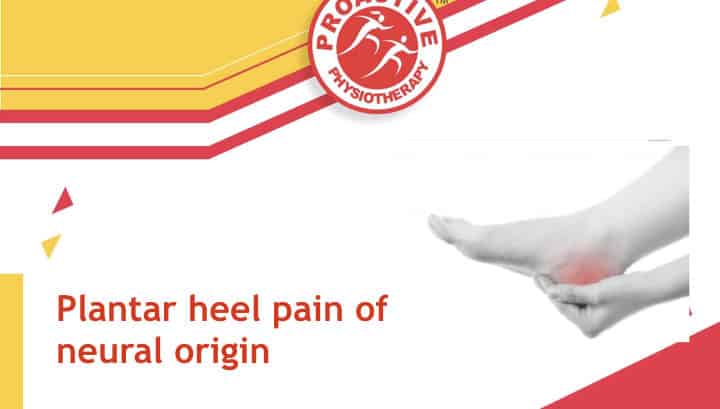Plantar Heel Pain and neural origin Part 2
In case, if you have missed our previous post click here Part 1
Differential diagnosis:
Hendrix et al (1998) found that all of their 51 patients with chronic plantar heel pain due to nerve entrapment showed the following symptoms
(1) loss of plantar sensation,
(2) a positive plantar flexion-inversion test,
(3) a positive Tinel’s test and
(4) pain and paraesthesia on nerve compression
Jolly et al. (2005) suggested that above-mentioned symptoms strongly support the heel pain of neural origin. However, the presence of only 1 symptom does not indicate the pain of neural origin.
It is found that QST and neurodynamic tests such as the modified straight-leg-raising test may also have a role in the diagnosis of plantar heel pain of neural origin.
Following conditions should be ruled out
- Plantar fasciitis :
Plantar fasciitis is the most common cause of plantar heel pain and the term has been used generically to describe heel pain at the origin of the plantar fascia on the medial calcaneal tuberosity. The typical presentation is pain after rest and first steps in the morning after coming out of bed also called as post static dis-kinesia. Tenderness is located at origin of the plantar fascia and along the fascia 2-3 cms distal to the origin.
- Fat pad atrophy:
In patients with a soft and thin heel fat pad, pain is usually aggravated by hard-soled shoes and walking on hard surfaces. Pain is most intense over the central portion of the heel fat pad (Fig. 5). The pain does not radiate, and the medial calcaneal tuberosity and plantar fascia are not tender.
- Tumours :
Although uncommon, benign tumours or neuromas of the first branch of the LPN (Shandles et al., 2002; Marui et al., 2004), MCN (Davidson, 1977) and MPN (Marui et al., 2004) have been related to plantar heel pain. Patients with neuroma of the MCN may complain of occasional local paraesthesia and loss of sensation (Davidson et al., 1977), and a Tinel’s test may also be positive (Davidson and Copoloff, 1990).
- Proximal nerve lesions:
Neurological examination should be performed to exclude proximal nerve disorders (Jolly et al., 2005). Schon et al. (1993) found that 2 patients out of 23 with plantar heel pain had electrophysiological evidence of S1 radiculopathy. The tibial nerve in the popliteal fossa can be compressed by the tendinous arch of the soleus muscle (Mastaglia, 2000) or by a Baker’s cyst (Willis and Carter, 1998), which can radiate pain to the heel
Other differential diagnoses such as rupture of the plantar fascia, bone fractures, bursitis, tendonitis, arthritis, osteomyelitis and bone cysts should also be considered.
Treatment
Surprisingly, according to the literature, the current treatment of plantar heel pain due to nerve entrapment is similar to other types of plantar heel pain
In general, conservative treatment of plantar heel pain may include rest, non-steroidal anti-inflammatory drugs, corticosteroid injections, extracorporeal shock wave therapy, laser, local anaesthetic injections, heel pads and heel cups, night splints, medial longitudinal arch supports, strapping, foot orthoses, soft-soled shoes, stretching exercises for the Achilles tendon and plantar fascia, ultrasound and casting.
They found limited evidence for the effectiveness of local corticosteroid therapy for short-term pain relief, usually around 4 weeks. However, complications such as plantar fascia rupture can result from corticosteroid injections.
There is a limited number of case studies that have applied nerve mobilisation techniques in the treatment of patients with plantar heel pain of neural origin (Shacklock, 1995; Meyer et al., 2002). Shacklock (1995) used knee extension movements in supine position in a patient with a neuropathy of the MCN and tibial nerve at the tarsal tunnel. Meyer et al. (2002) performed knee extension movements in a slump position in a patient with a possible entrapment of the MCN and tibial nerve at the ankle and/or at the arch of the soleus muscle. Both case studies reported positive outcomes with no adverse effects.
Surgery is considered if at least 6–12 months of conservative treatment has failed. Surgical decompression of the first branch of the LPN, MCN, LPN and MPN relieved symptoms in patients with plantar heel pain.
Referances
- Hendrix CL, Jolly GP, Garbalosa JC, Blume P, DosRemedios E. Entrapment neuropathy: the etiology of intractable chronic heel pain syndrome. The Journal of Foot and Ankle Surgery 1998; 37(4):273–9
- Jolly GP, Zgonis T, Hendrix CL. Neurogenic heel pain. Clinics in Podiatric Medicine and Surgery 2005;22(1):101–13.
- Shandles ID, Pruchniewski J, Reynolds KL. Heel neuroma: the enigma of recalcitrant heel pain and innovative approach highlighting sixty surgical cases and a review of two hundred and fifty-seven symptomatic but non-surgical cases. The Foot 2002;12:10–20.
- Marui T, Yamamoto T, Akisue T, Hitora T, Kawamoto T, Nagira K, et al. Neurilemmoma in the foot as a cause of heel pain: a report of two cases. Foot and Ankle International 2004;25(2):107–11.
- Davidson MR. Heel neuroma: identification and removal. Journal of the American Podiatry Association 1977;67(6):431–5.
- Davidson MR, Copoloff JA. Neuromas of the heel. Clinics in Podiatric Medicine and Surgery 1990;7(2):271–88.
- Shacklock MO. Clinical application of neurodynamics. In: Shacklock MO, editor. Moving in on pain. Chatswood: ButterworthHeinemann; 1995. p. 123–31.
- Meyer J, Kulig K, Landel R. Differential diagnosis and treatment of subcalcaneal heel pain: a case report. Journal of Orthopaedic and Sports Physical Therapy 2002;32(3):114–22 [discussion 122–4].




Leave a Reply
Want to join the discussion?Feel free to contribute!